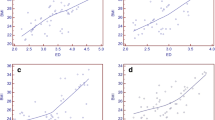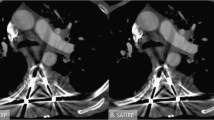Abstract
Objectives
To compare image quality and radiation dose of high-pitch dual-source computed tomography (DSCT), dual energy CT (DECT) and conventional single-source spiral CT (SCT) for pulmonary CT angiography (CTA) on a 128-slice CT system.
Methods
Pulmonary CTA was performed with five protocols: high-pitch DSCT (100 kV), high-pitch DSCT (120 kV), DECT (100/140 kV), SCT (100 kV), and SCT (120 kV). For each protocol, 30 sex, age, and body-mass-index (mean 25.3 kg/m2) matched patients were identified. Retrospectively, two observers subjectively assessed image quality, measured CT attenuation (HU±SD) at seven central and peripheral levels, and calculated signal-to-noise-ratio (SNR) and contrast-to-noise-ratio (CNR). Radiation exposure parameters (CTDIvol and DLP) were compared.
Results
Subjective image quality was rated good to excellent in >92% (>138/150) with an interobserver agreement of 91.4%. The five protocols did not significantly differ in image quality, neither by subjective, nor by objective measures (SNR, CNR). By contrast, radiation exposure differed between protocols: significant lower radiation was achieved by using high-pitch DSCT at 100 kV (p < 0.01 in all). Radiation exposure of DECT was in between SCT at 100 kV and 120 kV.
Conclusions
SCT, high-pitch DSCT, and DECT protocols techniques result in similar subjective and objective image quality, but radiation exposure was significantly lower with high-pitch DSCT at 100 kV.
Key Points
-
New CT protocols show promising results in pulmonary embolism assessment.
-
High-pitch dual-source CT (DSCT) at 100 kV provides radiation dose savings for pulmonary CTA.
-
High-pitch DSCT at 100 kV maintains diagnostic image quality for pulmonary CTA.
-
Dual energy CT uses more radiation but also provides lung perfusion evaluation.
-
Whether the additional perfusion data is worth the extra radiation remains undetermined.




Similar content being viewed by others
References
Remy-Jardin M, Pistolesi M, Goodman LR, Gefter WB, Gottschalk A, Mayo JR, Sostman HD (2007) Management of suspected acute pulmonary embolism in the era of CT angiography: a statement from the Fleischner Society. Radiology 245:315–329
Qanadli SD, Hajjam ME, Mesurolle B et al (2000) Pulmonary embolism detection: prospective evaluation of dual-section helical CT versus selective pulmonary arteriography in 157 patients. Radiology 217:447–455
Winer-Muram HT, Rydberg J, Johnson MS et al (2004) Suspected acute pulmonary embolism: evaluation with multi-detector row CT versus digital subtraction pulmonary arteriography. Radiology 233:806–815
Stein PD, Fowler SE, Goodman LR et al (2006) Multidetector computed tomography for acute pulmonary embolism. N Engl J Med 354:2317–2327
Flohr TG, Bruder H, Stierstorfer K et al (2008) Image reconstruction and image quality evaluation for a dual source CT scanner. Med Phys 35:5882–5897
Petersilka M, Bruder H, Krauss B et al (2008) Technical principles of dual source CT. Eur J Radiol 68:362–368
Sommer WH, Schenzle JC, Becker CR, Nikolaou K, Graser A, Michalski G, Neumaier K, Reiser MF, Johnson TR (2010) Saving dose in triple-rule-out computed tomography examination using a high-pitch dual spiral technique. Invest Radiol 45:64–71
Johnson TRC, Krauss B, Sedlmair M et al (2007) Material differentiation by dual energy CT: initial experience. Eur Radiol 17:1510–1517
Ferda J, Flohr T, Kreuzberg B (2008) Tissue imaging with dual-energy computed tomography—initial clinical experience. Ces Radiol 62:11–22
Fink C, Johnson TR, Michaely HJ et al (2008) Dual-energy CT angiography of the lung in patients with suspected pulmonary embolism: initial results. Rofo 180:879–883
Pontana F, Faivre JB, Remy-Jardin M et al (2008) Lung perfusion with dual-energy multidetector-row CT (MDCT): feasibility for the evaluation of acute pulmonary embolism in 117 consecutive patients. Acad Radiol 15:1494–1504
Thieme SF, Becker CR, Hacker M, Nikolaou K, Reiser MF, Johnson TR (2008) Dual energy CT for the assessment of lung perfusion–correlation to scintigraphy. Eur J Radiol 68:369–374
Hoey ET, Gopalan D, Ganesh V et al (2009) Dual-energy CT pulmonary angiography: a novel technique for assessing acute and chronic pulmonary thromboembolism. Clin Radiol 64:414–419
Chae EJ, Seo JB, Jang YM, Krauss B, Lee CW, Lee HJ, Song KS (2010) Dual-energy CT for assessment of the severity of acute pulmonary embolism: pulmonary perfusion defect score compared with CT angiographic obstruction score and right ventricular/left ventricular diameter ratio. AJR Am J Roentgenol 194:604–610
Primak AN, Giraldo JCR, Eusemann CD, Schmidt B, Kantor B, Fletcher JG, McCollough CH (2010) Dual-source dual-energy CT with additional tin filtration: dose and image quality evaluation in phantoms and in vivo. AJR Am J Roentgenol 195:1164–1174
International Commission on Radiological Protection and Measurements. Radiological protection and safety. International Commission on Radiological Protection Measurements publication no. 60. Oxford, England: Pergamon, 1991
Chae EJ, Song JW, Seo JB, Krauss B, Jang YM, Song KS (2008) Clinical utility of dual-energy CT in the evaluation of solitary pulmonary nodules: initial experience. Radiology 249:671–681
Flohr TG, Leng S, Yu L et al (2009) Dual-source spiral CT with pitch up to 3.2 and 75 ms temporal resolution: image reconstruction and assessment of image quality. Med Phys 36:5641–5653
Kristiansson M, Holmquist F, Nyman U (2010) Ultralow contrast medium doses at CT to diagnose pulmonary embolism in patients with moderate to severe renal impairment: a feasibility study. Eur Radiol 20:1321–1330
Schoellnast H, Deutschmann HA, Fritz GA, Stessel U, Schaffler GJ, Tillich M (2005) MDCT angiography of the pulmonary arteries: influence of iodine flow concentration on vessel attenuation and visualization. AJR Am J Roentgenol 184:1935–1939
Ghaye B, Szapiro D, Mastora I et al (2001) Peripheral pulmonary arteries: how far does multidetector–row spiral CT allow analysis? Radiology 219:629–636
Schoepf UJ, Goldhaber SZ, Costello P (2004) Spiral computed tomography for acute pulmonary embolism. Circulation 109:2160–2167
Coche E, Verschuren F, Keyeux A et al (2003) Diagnosis of acute pulmonary embolism in outpatients: comparison of thin-collimation multi– detector row spiral CT and planar ventilation-perfusion scintigraphy. Radiology 229:757–765
Raptopoulos V, Boiselle PM (2001) Multi–detector row spiral CT pulmonary angiography: comparison with single–detector row spiral CT. Radiology 221:606–613
Schoepf UJ, Holzknecht N, Helmberger TK et al (2002) Subsegmental pulmonary emboli: improved detection with thin-collimation multi– detector row spiral CT. Radiology 222:483–490
Patel S, Kazerooni EA, Cascade PN (2003) Pulmonary embolism: optimization of small pulmonary artery visualization at multi– detector row CT. Radiology 227:455–460
Brunot S, Corneloup O, Latrabe V, Montaudon M, Laurent F (2005) Reproducibility of multidetector spiral computed tomography in detection of subsegmental acute pulmonary embolism. Eur Radiol 15:2057–2063
Schertler T, Scheffel H, Frauenfelder T, Desbiolles L, Leschka S, Stolzmann P, Seifert B, Flohr TG, Marincek B, Alkadhi H (2007) Dual-source computed tomography in patients with acute chest pain: feasibility and image quality. Eur Radiol 17:3179–3188
Valentin J (2007) The 2007 recommendations of the International Commission on Radiological Protection. ICRP publication 103. Ann ICRP 37:1–332
Schenzle JC, Sommer WH, Neumaier K, Michalski G, Lechel U, Nikolaou K, Becker CR, Reiser MF, Johnson TR (2010) Dual energy CT of the chest: how about the dose? Invest Radiol 45:347–353
Bauer RW, Kramer S, Renker M, Schell B, Larson MC, Beeres M, Lehnert T, Jacobi V, Vogl TJ, Kerl JM (2011) Dose and image quality at CT pulmonary angiography-comparison of first and second generation dual-energy CT and 64-slice CT. Eur Radiol. doi:10.1007/s00330-011-2162-y
Bauer RW, Frellesen C, Renker M, Schell B, Lehnert T, Ackermann H, Schoepf UJ, Jacobi V, Vogl TJ, Kerl JM (2011) Dual energy CT pulmonary blood volume assessment in acute pulmonary embolism—correlation with D-dimer level, right heart strain and clinical outcome. Eur Radiol. doi:10.1007/s00330-011-2135-1
Björkdahl P, Nyman U (2010) Using 100- instead of 120-kVp computed tomography to diagnose pulmonary embolism almost halves the radiation dose with preserved diagnostic quality. Acta Radiol 51:260–270
Author information
Authors and Affiliations
Corresponding author
Rights and permissions
About this article
Cite this article
De Zordo, T., von Lutterotti, K., Dejaco, C. et al. Comparison of image quality and radiation dose of different pulmonary CTA protocols on a 128-slice CT: high-pitch dual source CT, dual energy CT and conventional spiral CT. Eur Radiol 22, 279–286 (2012). https://doi.org/10.1007/s00330-011-2251-y
Received:
Revised:
Accepted:
Published:
Issue Date:
DOI: https://doi.org/10.1007/s00330-011-2251-y




